An Investigation into Luxury Brands' Collaboration with Fast Fashion
VerifiedAdded on 2022/10/04
|25
|7539
|11
Report
AI Summary
This report is a literature review analyzing the collaboration strategies between luxury brands and fast fashion brands. It explores the motives behind these partnerships, including market size expansion, competitive dynamics, resource utilization, and product innovation. The report examines the utility of collaborative strategies, their implementation, and their impact on brand equity, customer purchase intentions, and customer retention. The study also identifies gaps in existing literature and summarizes the key findings, providing a comprehensive understanding of the co-branding phenomenon in the fashion industry. The paper provides a detailed overview of the luxury and fast fashion industries, their respective characteristics, and the benefits each derives from these collaborations.
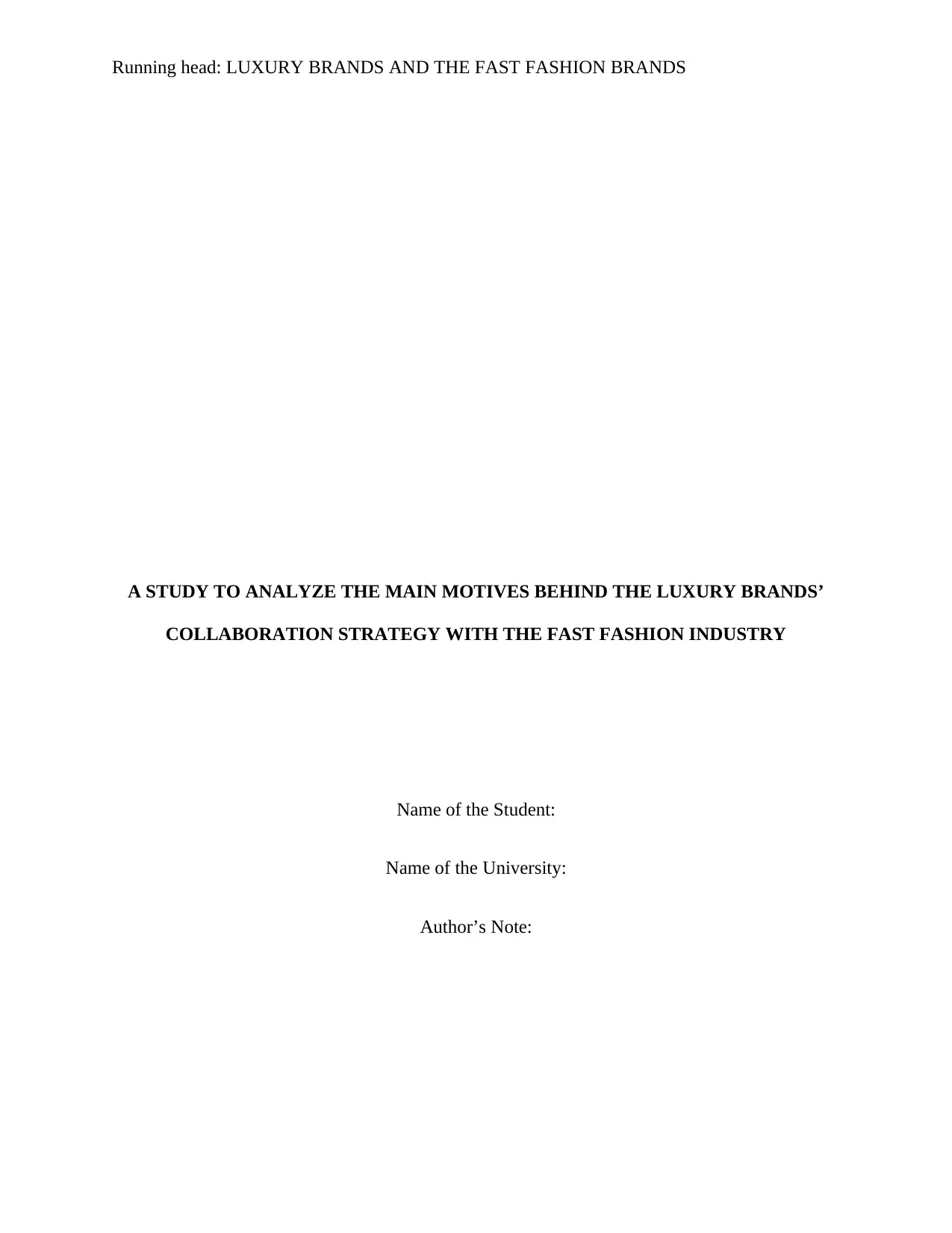
Running head: LUXURY BRANDS AND THE FAST FASHION BRANDS
A STUDY TO ANALYZE THE MAIN MOTIVES BEHIND THE LUXURY BRANDS’
COLLABORATION STRATEGY WITH THE FAST FASHION INDUSTRY
Name of the Student:
Name of the University:
Author’s Note:
A STUDY TO ANALYZE THE MAIN MOTIVES BEHIND THE LUXURY BRANDS’
COLLABORATION STRATEGY WITH THE FAST FASHION INDUSTRY
Name of the Student:
Name of the University:
Author’s Note:
Paraphrase This Document
Need a fresh take? Get an instant paraphrase of this document with our AI Paraphraser
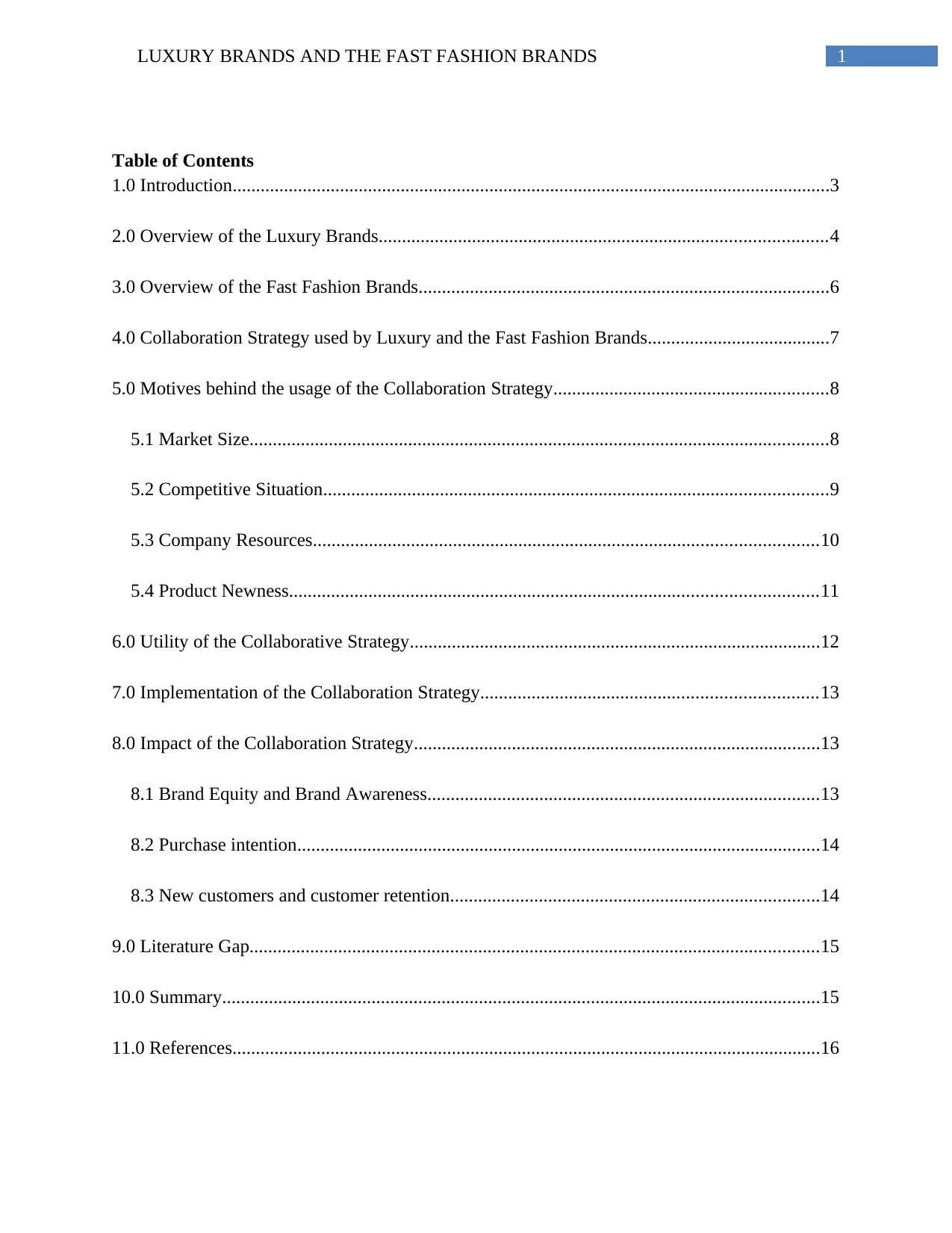
1LUXURY BRANDS AND THE FAST FASHION BRANDS
Table of Contents
1.0 Introduction................................................................................................................................3
2.0 Overview of the Luxury Brands................................................................................................4
3.0 Overview of the Fast Fashion Brands........................................................................................6
4.0 Collaboration Strategy used by Luxury and the Fast Fashion Brands.......................................7
5.0 Motives behind the usage of the Collaboration Strategy...........................................................8
5.1 Market Size............................................................................................................................8
5.2 Competitive Situation............................................................................................................9
5.3 Company Resources............................................................................................................10
5.4 Product Newness.................................................................................................................11
6.0 Utility of the Collaborative Strategy........................................................................................12
7.0 Implementation of the Collaboration Strategy........................................................................13
8.0 Impact of the Collaboration Strategy.......................................................................................13
8.1 Brand Equity and Brand Awareness....................................................................................13
8.2 Purchase intention................................................................................................................14
8.3 New customers and customer retention...............................................................................14
9.0 Literature Gap..........................................................................................................................15
10.0 Summary................................................................................................................................15
11.0 References..............................................................................................................................16
Table of Contents
1.0 Introduction................................................................................................................................3
2.0 Overview of the Luxury Brands................................................................................................4
3.0 Overview of the Fast Fashion Brands........................................................................................6
4.0 Collaboration Strategy used by Luxury and the Fast Fashion Brands.......................................7
5.0 Motives behind the usage of the Collaboration Strategy...........................................................8
5.1 Market Size............................................................................................................................8
5.2 Competitive Situation............................................................................................................9
5.3 Company Resources............................................................................................................10
5.4 Product Newness.................................................................................................................11
6.0 Utility of the Collaborative Strategy........................................................................................12
7.0 Implementation of the Collaboration Strategy........................................................................13
8.0 Impact of the Collaboration Strategy.......................................................................................13
8.1 Brand Equity and Brand Awareness....................................................................................13
8.2 Purchase intention................................................................................................................14
8.3 New customers and customer retention...............................................................................14
9.0 Literature Gap..........................................................................................................................15
10.0 Summary................................................................................................................................15
11.0 References..............................................................................................................................16
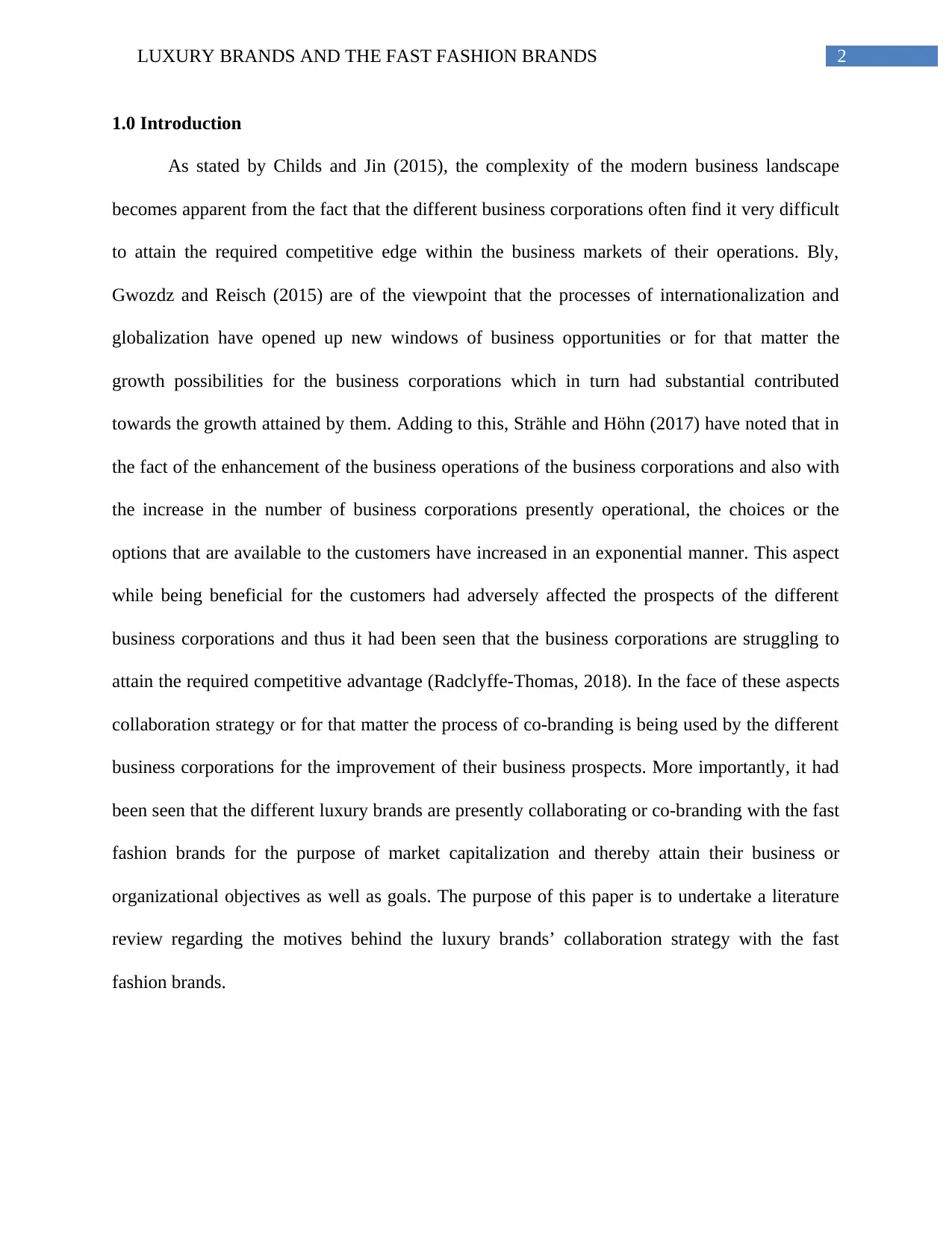
2LUXURY BRANDS AND THE FAST FASHION BRANDS
1.0 Introduction
As stated by Childs and Jin (2015), the complexity of the modern business landscape
becomes apparent from the fact that the different business corporations often find it very difficult
to attain the required competitive edge within the business markets of their operations. Bly,
Gwozdz and Reisch (2015) are of the viewpoint that the processes of internationalization and
globalization have opened up new windows of business opportunities or for that matter the
growth possibilities for the business corporations which in turn had substantial contributed
towards the growth attained by them. Adding to this, Strähle and Höhn (2017) have noted that in
the fact of the enhancement of the business operations of the business corporations and also with
the increase in the number of business corporations presently operational, the choices or the
options that are available to the customers have increased in an exponential manner. This aspect
while being beneficial for the customers had adversely affected the prospects of the different
business corporations and thus it had been seen that the business corporations are struggling to
attain the required competitive advantage (Radclyffe-Thomas, 2018). In the face of these aspects
collaboration strategy or for that matter the process of co-branding is being used by the different
business corporations for the improvement of their business prospects. More importantly, it had
been seen that the different luxury brands are presently collaborating or co-branding with the fast
fashion brands for the purpose of market capitalization and thereby attain their business or
organizational objectives as well as goals. The purpose of this paper is to undertake a literature
review regarding the motives behind the luxury brands’ collaboration strategy with the fast
fashion brands.
1.0 Introduction
As stated by Childs and Jin (2015), the complexity of the modern business landscape
becomes apparent from the fact that the different business corporations often find it very difficult
to attain the required competitive edge within the business markets of their operations. Bly,
Gwozdz and Reisch (2015) are of the viewpoint that the processes of internationalization and
globalization have opened up new windows of business opportunities or for that matter the
growth possibilities for the business corporations which in turn had substantial contributed
towards the growth attained by them. Adding to this, Strähle and Höhn (2017) have noted that in
the fact of the enhancement of the business operations of the business corporations and also with
the increase in the number of business corporations presently operational, the choices or the
options that are available to the customers have increased in an exponential manner. This aspect
while being beneficial for the customers had adversely affected the prospects of the different
business corporations and thus it had been seen that the business corporations are struggling to
attain the required competitive advantage (Radclyffe-Thomas, 2018). In the face of these aspects
collaboration strategy or for that matter the process of co-branding is being used by the different
business corporations for the improvement of their business prospects. More importantly, it had
been seen that the different luxury brands are presently collaborating or co-branding with the fast
fashion brands for the purpose of market capitalization and thereby attain their business or
organizational objectives as well as goals. The purpose of this paper is to undertake a literature
review regarding the motives behind the luxury brands’ collaboration strategy with the fast
fashion brands.
⊘ This is a preview!⊘
Do you want full access?
Subscribe today to unlock all pages.

Trusted by 1+ million students worldwide
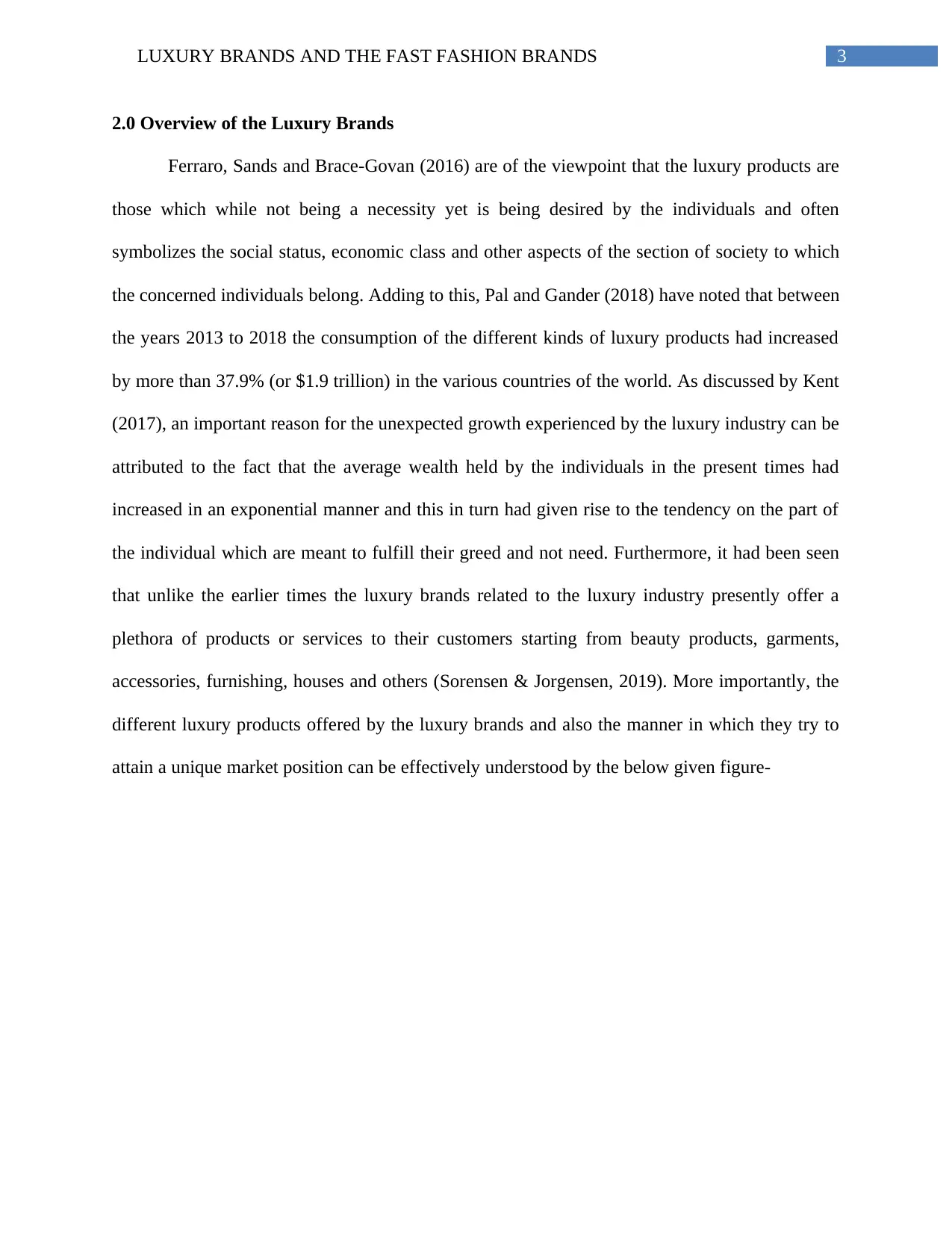
3LUXURY BRANDS AND THE FAST FASHION BRANDS
2.0 Overview of the Luxury Brands
Ferraro, Sands and Brace-Govan (2016) are of the viewpoint that the luxury products are
those which while not being a necessity yet is being desired by the individuals and often
symbolizes the social status, economic class and other aspects of the section of society to which
the concerned individuals belong. Adding to this, Pal and Gander (2018) have noted that between
the years 2013 to 2018 the consumption of the different kinds of luxury products had increased
by more than 37.9% (or $1.9 trillion) in the various countries of the world. As discussed by Kent
(2017), an important reason for the unexpected growth experienced by the luxury industry can be
attributed to the fact that the average wealth held by the individuals in the present times had
increased in an exponential manner and this in turn had given rise to the tendency on the part of
the individual which are meant to fulfill their greed and not need. Furthermore, it had been seen
that unlike the earlier times the luxury brands related to the luxury industry presently offer a
plethora of products or services to their customers starting from beauty products, garments,
accessories, furnishing, houses and others (Sorensen & Jorgensen, 2019). More importantly, the
different luxury products offered by the luxury brands and also the manner in which they try to
attain a unique market position can be effectively understood by the below given figure-
2.0 Overview of the Luxury Brands
Ferraro, Sands and Brace-Govan (2016) are of the viewpoint that the luxury products are
those which while not being a necessity yet is being desired by the individuals and often
symbolizes the social status, economic class and other aspects of the section of society to which
the concerned individuals belong. Adding to this, Pal and Gander (2018) have noted that between
the years 2013 to 2018 the consumption of the different kinds of luxury products had increased
by more than 37.9% (or $1.9 trillion) in the various countries of the world. As discussed by Kent
(2017), an important reason for the unexpected growth experienced by the luxury industry can be
attributed to the fact that the average wealth held by the individuals in the present times had
increased in an exponential manner and this in turn had given rise to the tendency on the part of
the individual which are meant to fulfill their greed and not need. Furthermore, it had been seen
that unlike the earlier times the luxury brands related to the luxury industry presently offer a
plethora of products or services to their customers starting from beauty products, garments,
accessories, furnishing, houses and others (Sorensen & Jorgensen, 2019). More importantly, the
different luxury products offered by the luxury brands and also the manner in which they try to
attain a unique market position can be effectively understood by the below given figure-
Paraphrase This Document
Need a fresh take? Get an instant paraphrase of this document with our AI Paraphraser
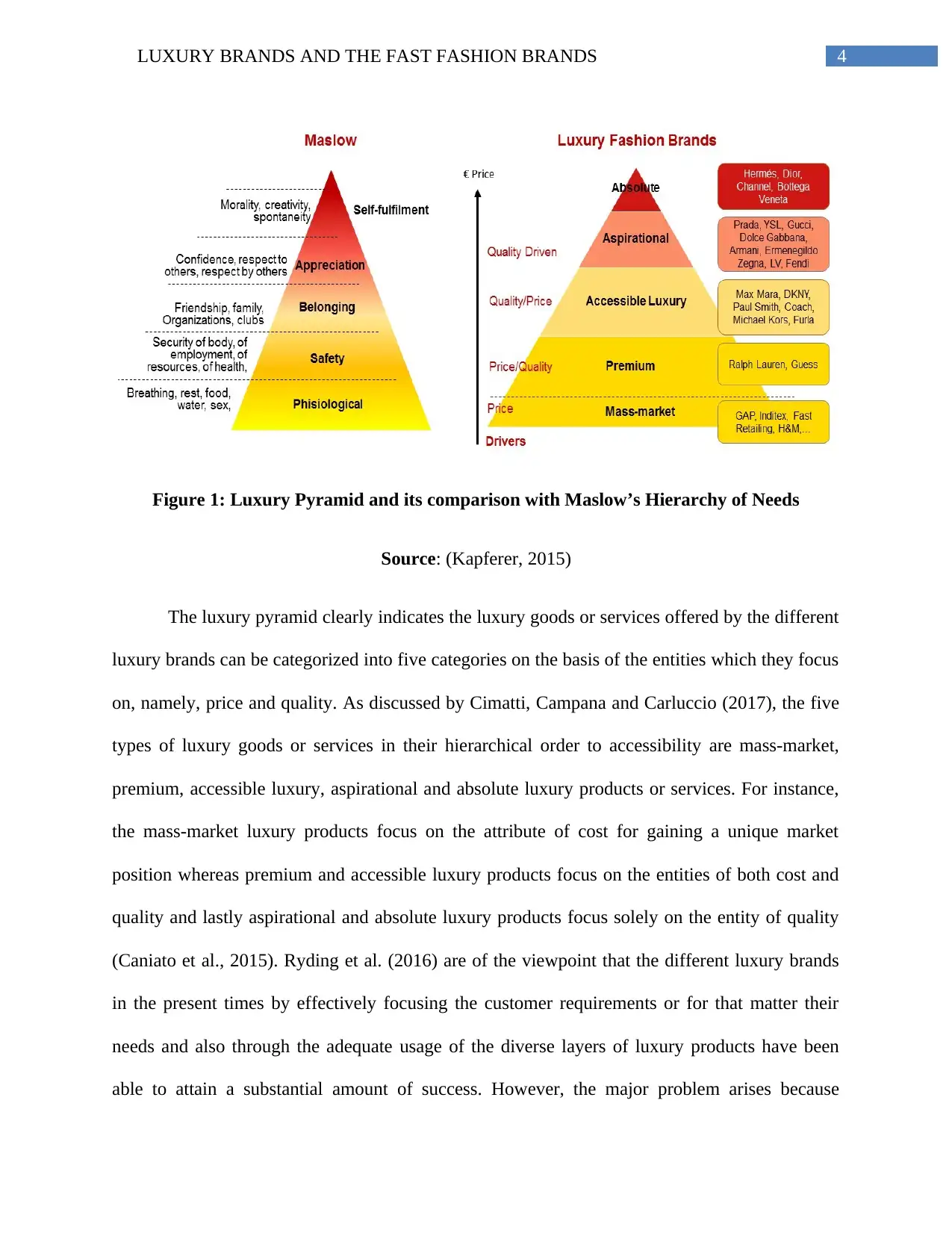
4LUXURY BRANDS AND THE FAST FASHION BRANDS
Figure 1: Luxury Pyramid and its comparison with Maslow’s Hierarchy of Needs
Source: (Kapferer, 2015)
The luxury pyramid clearly indicates the luxury goods or services offered by the different
luxury brands can be categorized into five categories on the basis of the entities which they focus
on, namely, price and quality. As discussed by Cimatti, Campana and Carluccio (2017), the five
types of luxury goods or services in their hierarchical order to accessibility are mass-market,
premium, accessible luxury, aspirational and absolute luxury products or services. For instance,
the mass-market luxury products focus on the attribute of cost for gaining a unique market
position whereas premium and accessible luxury products focus on the entities of both cost and
quality and lastly aspirational and absolute luxury products focus solely on the entity of quality
(Caniato et al., 2015). Ryding et al. (2016) are of the viewpoint that the different luxury brands
in the present times by effectively focusing the customer requirements or for that matter their
needs and also through the adequate usage of the diverse layers of luxury products have been
able to attain a substantial amount of success. However, the major problem arises because
Figure 1: Luxury Pyramid and its comparison with Maslow’s Hierarchy of Needs
Source: (Kapferer, 2015)
The luxury pyramid clearly indicates the luxury goods or services offered by the different
luxury brands can be categorized into five categories on the basis of the entities which they focus
on, namely, price and quality. As discussed by Cimatti, Campana and Carluccio (2017), the five
types of luxury goods or services in their hierarchical order to accessibility are mass-market,
premium, accessible luxury, aspirational and absolute luxury products or services. For instance,
the mass-market luxury products focus on the attribute of cost for gaining a unique market
position whereas premium and accessible luxury products focus on the entities of both cost and
quality and lastly aspirational and absolute luxury products focus solely on the entity of quality
(Caniato et al., 2015). Ryding et al. (2016) are of the viewpoint that the different luxury brands
in the present times by effectively focusing the customer requirements or for that matter their
needs and also through the adequate usage of the diverse layers of luxury products have been
able to attain a substantial amount of success. However, the major problem arises because
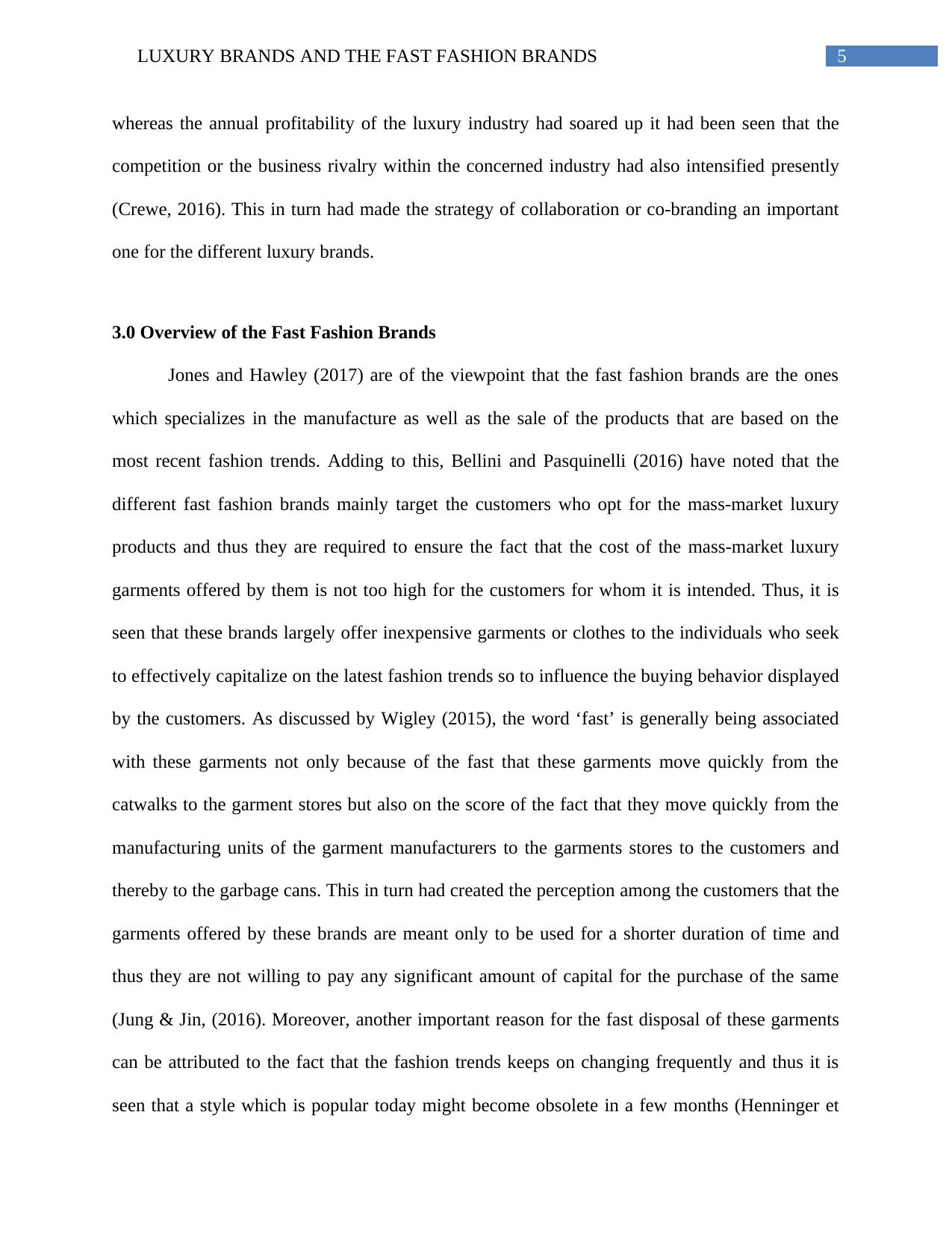
5LUXURY BRANDS AND THE FAST FASHION BRANDS
whereas the annual profitability of the luxury industry had soared up it had been seen that the
competition or the business rivalry within the concerned industry had also intensified presently
(Crewe, 2016). This in turn had made the strategy of collaboration or co-branding an important
one for the different luxury brands.
3.0 Overview of the Fast Fashion Brands
Jones and Hawley (2017) are of the viewpoint that the fast fashion brands are the ones
which specializes in the manufacture as well as the sale of the products that are based on the
most recent fashion trends. Adding to this, Bellini and Pasquinelli (2016) have noted that the
different fast fashion brands mainly target the customers who opt for the mass-market luxury
products and thus they are required to ensure the fact that the cost of the mass-market luxury
garments offered by them is not too high for the customers for whom it is intended. Thus, it is
seen that these brands largely offer inexpensive garments or clothes to the individuals who seek
to effectively capitalize on the latest fashion trends so to influence the buying behavior displayed
by the customers. As discussed by Wigley (2015), the word ‘fast’ is generally being associated
with these garments not only because of the fast that these garments move quickly from the
catwalks to the garment stores but also on the score of the fact that they move quickly from the
manufacturing units of the garment manufacturers to the garments stores to the customers and
thereby to the garbage cans. This in turn had created the perception among the customers that the
garments offered by these brands are meant only to be used for a shorter duration of time and
thus they are not willing to pay any significant amount of capital for the purchase of the same
(Jung & Jin, (2016). Moreover, another important reason for the fast disposal of these garments
can be attributed to the fact that the fashion trends keeps on changing frequently and thus it is
seen that a style which is popular today might become obsolete in a few months (Henninger et
whereas the annual profitability of the luxury industry had soared up it had been seen that the
competition or the business rivalry within the concerned industry had also intensified presently
(Crewe, 2016). This in turn had made the strategy of collaboration or co-branding an important
one for the different luxury brands.
3.0 Overview of the Fast Fashion Brands
Jones and Hawley (2017) are of the viewpoint that the fast fashion brands are the ones
which specializes in the manufacture as well as the sale of the products that are based on the
most recent fashion trends. Adding to this, Bellini and Pasquinelli (2016) have noted that the
different fast fashion brands mainly target the customers who opt for the mass-market luxury
products and thus they are required to ensure the fact that the cost of the mass-market luxury
garments offered by them is not too high for the customers for whom it is intended. Thus, it is
seen that these brands largely offer inexpensive garments or clothes to the individuals who seek
to effectively capitalize on the latest fashion trends so to influence the buying behavior displayed
by the customers. As discussed by Wigley (2015), the word ‘fast’ is generally being associated
with these garments not only because of the fast that these garments move quickly from the
catwalks to the garment stores but also on the score of the fact that they move quickly from the
manufacturing units of the garment manufacturers to the garments stores to the customers and
thereby to the garbage cans. This in turn had created the perception among the customers that the
garments offered by these brands are meant only to be used for a shorter duration of time and
thus they are not willing to pay any significant amount of capital for the purchase of the same
(Jung & Jin, (2016). Moreover, another important reason for the fast disposal of these garments
can be attributed to the fact that the fashion trends keeps on changing frequently and thus it is
seen that a style which is popular today might become obsolete in a few months (Henninger et
⊘ This is a preview!⊘
Do you want full access?
Subscribe today to unlock all pages.

Trusted by 1+ million students worldwide
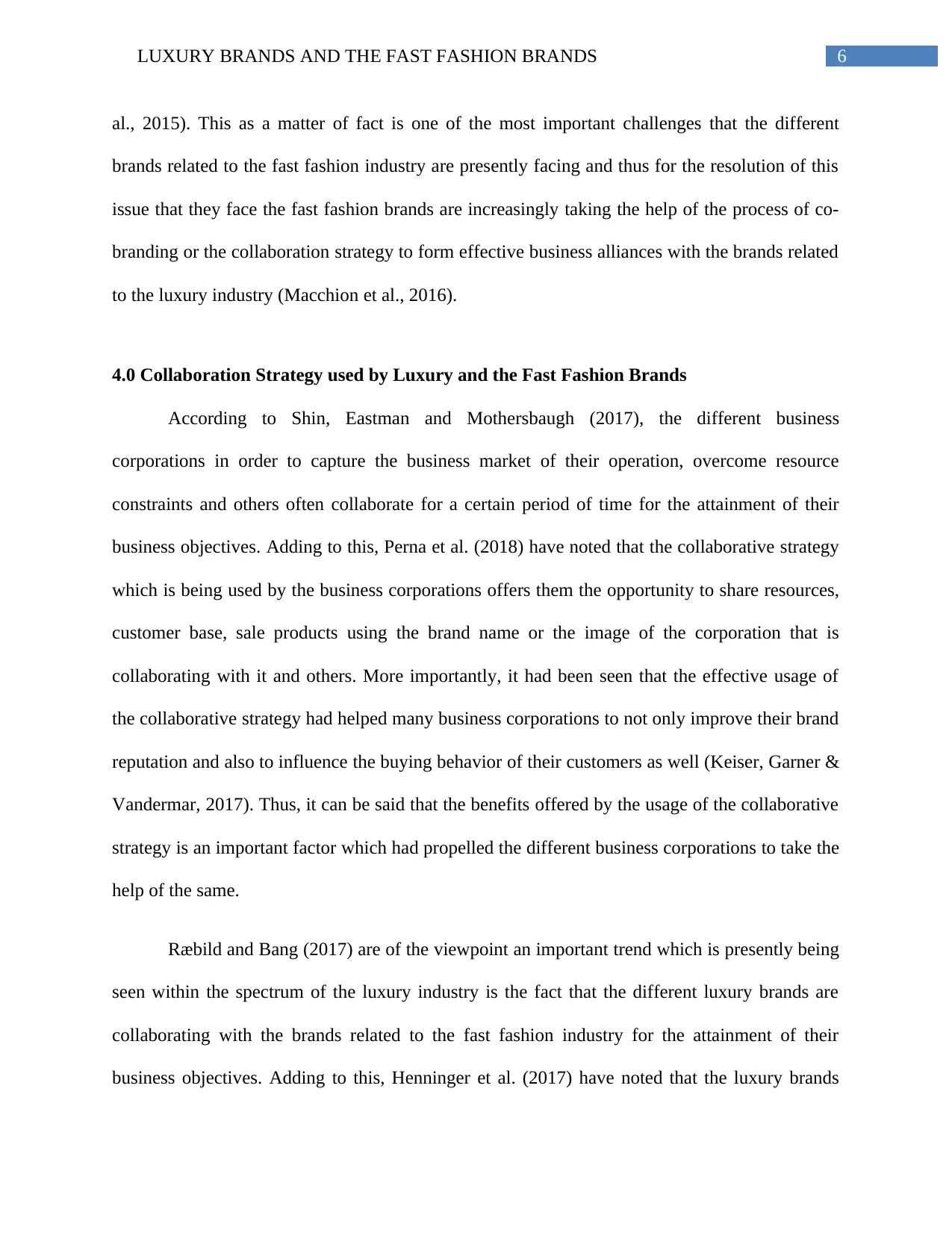
6LUXURY BRANDS AND THE FAST FASHION BRANDS
al., 2015). This as a matter of fact is one of the most important challenges that the different
brands related to the fast fashion industry are presently facing and thus for the resolution of this
issue that they face the fast fashion brands are increasingly taking the help of the process of co-
branding or the collaboration strategy to form effective business alliances with the brands related
to the luxury industry (Macchion et al., 2016).
4.0 Collaboration Strategy used by Luxury and the Fast Fashion Brands
According to Shin, Eastman and Mothersbaugh (2017), the different business
corporations in order to capture the business market of their operation, overcome resource
constraints and others often collaborate for a certain period of time for the attainment of their
business objectives. Adding to this, Perna et al. (2018) have noted that the collaborative strategy
which is being used by the business corporations offers them the opportunity to share resources,
customer base, sale products using the brand name or the image of the corporation that is
collaborating with it and others. More importantly, it had been seen that the effective usage of
the collaborative strategy had helped many business corporations to not only improve their brand
reputation and also to influence the buying behavior of their customers as well (Keiser, Garner &
Vandermar, 2017). Thus, it can be said that the benefits offered by the usage of the collaborative
strategy is an important factor which had propelled the different business corporations to take the
help of the same.
Ræbild and Bang (2017) are of the viewpoint an important trend which is presently being
seen within the spectrum of the luxury industry is the fact that the different luxury brands are
collaborating with the brands related to the fast fashion industry for the attainment of their
business objectives. Adding to this, Henninger et al. (2017) have noted that the luxury brands
al., 2015). This as a matter of fact is one of the most important challenges that the different
brands related to the fast fashion industry are presently facing and thus for the resolution of this
issue that they face the fast fashion brands are increasingly taking the help of the process of co-
branding or the collaboration strategy to form effective business alliances with the brands related
to the luxury industry (Macchion et al., 2016).
4.0 Collaboration Strategy used by Luxury and the Fast Fashion Brands
According to Shin, Eastman and Mothersbaugh (2017), the different business
corporations in order to capture the business market of their operation, overcome resource
constraints and others often collaborate for a certain period of time for the attainment of their
business objectives. Adding to this, Perna et al. (2018) have noted that the collaborative strategy
which is being used by the business corporations offers them the opportunity to share resources,
customer base, sale products using the brand name or the image of the corporation that is
collaborating with it and others. More importantly, it had been seen that the effective usage of
the collaborative strategy had helped many business corporations to not only improve their brand
reputation and also to influence the buying behavior of their customers as well (Keiser, Garner &
Vandermar, 2017). Thus, it can be said that the benefits offered by the usage of the collaborative
strategy is an important factor which had propelled the different business corporations to take the
help of the same.
Ræbild and Bang (2017) are of the viewpoint an important trend which is presently being
seen within the spectrum of the luxury industry is the fact that the different luxury brands are
collaborating with the brands related to the fast fashion industry for the attainment of their
business objectives. Adding to this, Henninger et al. (2017) have noted that the luxury brands
Paraphrase This Document
Need a fresh take? Get an instant paraphrase of this document with our AI Paraphraser
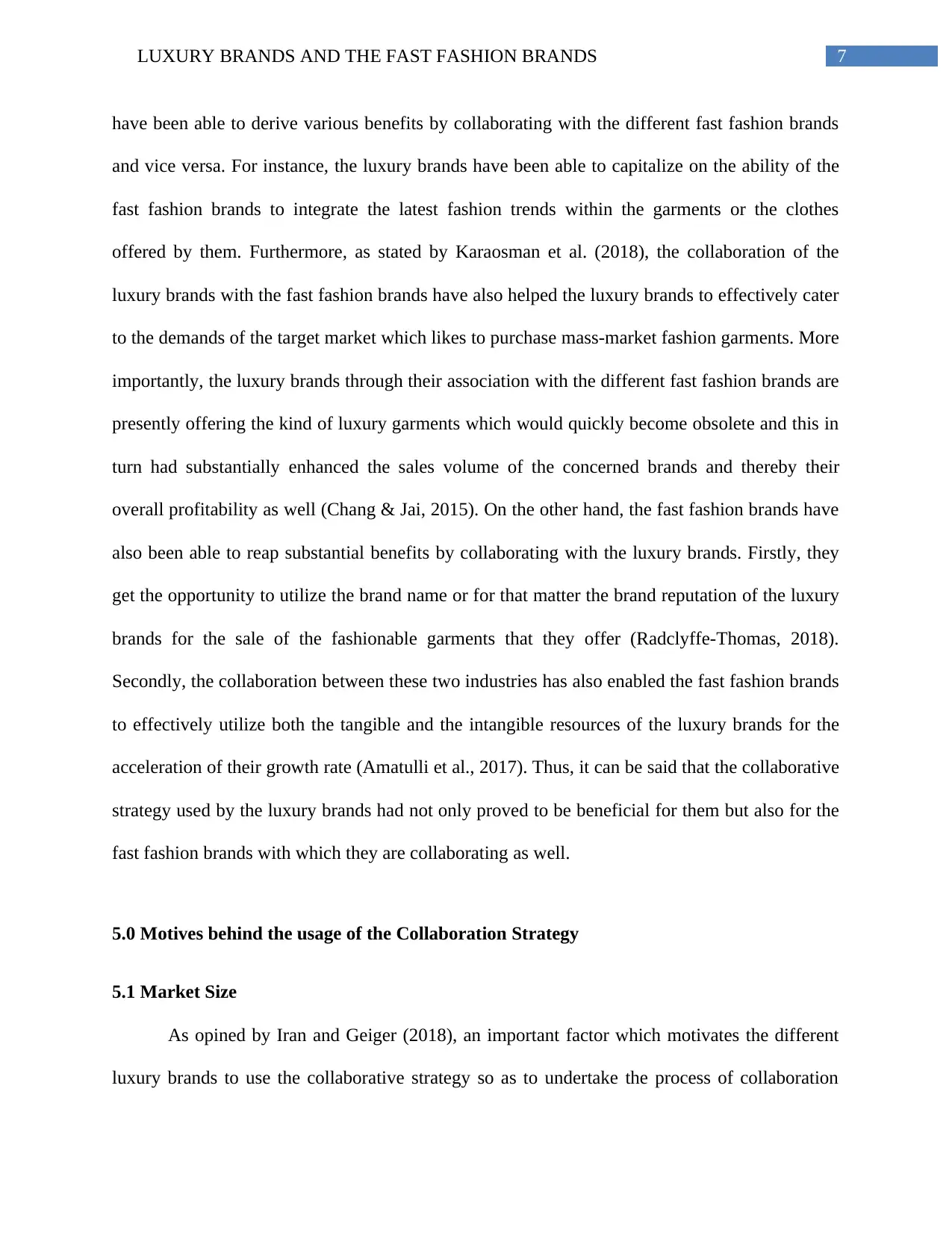
7LUXURY BRANDS AND THE FAST FASHION BRANDS
have been able to derive various benefits by collaborating with the different fast fashion brands
and vice versa. For instance, the luxury brands have been able to capitalize on the ability of the
fast fashion brands to integrate the latest fashion trends within the garments or the clothes
offered by them. Furthermore, as stated by Karaosman et al. (2018), the collaboration of the
luxury brands with the fast fashion brands have also helped the luxury brands to effectively cater
to the demands of the target market which likes to purchase mass-market fashion garments. More
importantly, the luxury brands through their association with the different fast fashion brands are
presently offering the kind of luxury garments which would quickly become obsolete and this in
turn had substantially enhanced the sales volume of the concerned brands and thereby their
overall profitability as well (Chang & Jai, 2015). On the other hand, the fast fashion brands have
also been able to reap substantial benefits by collaborating with the luxury brands. Firstly, they
get the opportunity to utilize the brand name or for that matter the brand reputation of the luxury
brands for the sale of the fashionable garments that they offer (Radclyffe-Thomas, 2018).
Secondly, the collaboration between these two industries has also enabled the fast fashion brands
to effectively utilize both the tangible and the intangible resources of the luxury brands for the
acceleration of their growth rate (Amatulli et al., 2017). Thus, it can be said that the collaborative
strategy used by the luxury brands had not only proved to be beneficial for them but also for the
fast fashion brands with which they are collaborating as well.
5.0 Motives behind the usage of the Collaboration Strategy
5.1 Market Size
As opined by Iran and Geiger (2018), an important factor which motivates the different
luxury brands to use the collaborative strategy so as to undertake the process of collaboration
have been able to derive various benefits by collaborating with the different fast fashion brands
and vice versa. For instance, the luxury brands have been able to capitalize on the ability of the
fast fashion brands to integrate the latest fashion trends within the garments or the clothes
offered by them. Furthermore, as stated by Karaosman et al. (2018), the collaboration of the
luxury brands with the fast fashion brands have also helped the luxury brands to effectively cater
to the demands of the target market which likes to purchase mass-market fashion garments. More
importantly, the luxury brands through their association with the different fast fashion brands are
presently offering the kind of luxury garments which would quickly become obsolete and this in
turn had substantially enhanced the sales volume of the concerned brands and thereby their
overall profitability as well (Chang & Jai, 2015). On the other hand, the fast fashion brands have
also been able to reap substantial benefits by collaborating with the luxury brands. Firstly, they
get the opportunity to utilize the brand name or for that matter the brand reputation of the luxury
brands for the sale of the fashionable garments that they offer (Radclyffe-Thomas, 2018).
Secondly, the collaboration between these two industries has also enabled the fast fashion brands
to effectively utilize both the tangible and the intangible resources of the luxury brands for the
acceleration of their growth rate (Amatulli et al., 2017). Thus, it can be said that the collaborative
strategy used by the luxury brands had not only proved to be beneficial for them but also for the
fast fashion brands with which they are collaborating as well.
5.0 Motives behind the usage of the Collaboration Strategy
5.1 Market Size
As opined by Iran and Geiger (2018), an important factor which motivates the different
luxury brands to use the collaborative strategy so as to undertake the process of collaboration
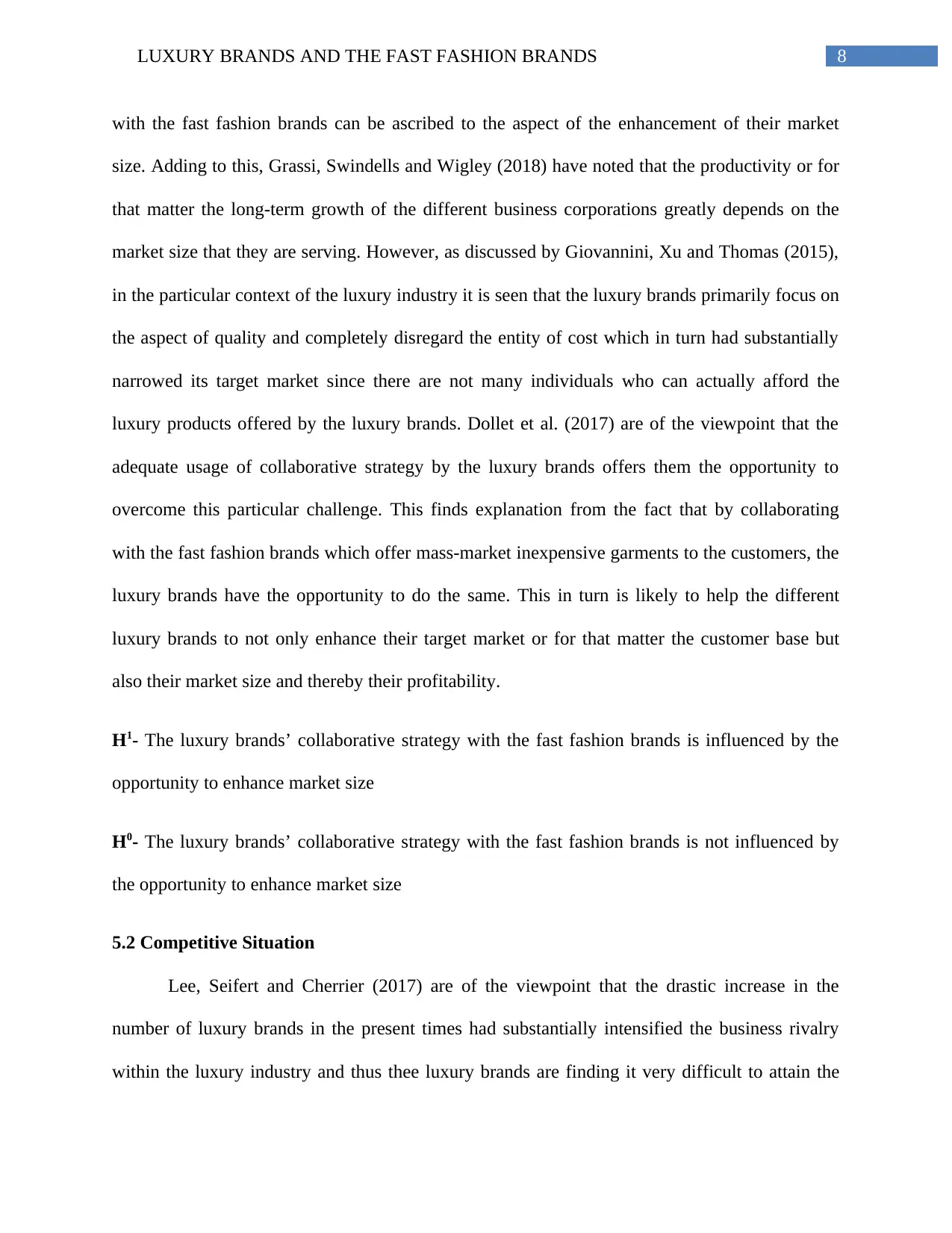
8LUXURY BRANDS AND THE FAST FASHION BRANDS
with the fast fashion brands can be ascribed to the aspect of the enhancement of their market
size. Adding to this, Grassi, Swindells and Wigley (2018) have noted that the productivity or for
that matter the long-term growth of the different business corporations greatly depends on the
market size that they are serving. However, as discussed by Giovannini, Xu and Thomas (2015),
in the particular context of the luxury industry it is seen that the luxury brands primarily focus on
the aspect of quality and completely disregard the entity of cost which in turn had substantially
narrowed its target market since there are not many individuals who can actually afford the
luxury products offered by the luxury brands. Dollet et al. (2017) are of the viewpoint that the
adequate usage of collaborative strategy by the luxury brands offers them the opportunity to
overcome this particular challenge. This finds explanation from the fact that by collaborating
with the fast fashion brands which offer mass-market inexpensive garments to the customers, the
luxury brands have the opportunity to do the same. This in turn is likely to help the different
luxury brands to not only enhance their target market or for that matter the customer base but
also their market size and thereby their profitability.
H1- The luxury brands’ collaborative strategy with the fast fashion brands is influenced by the
opportunity to enhance market size
H0- The luxury brands’ collaborative strategy with the fast fashion brands is not influenced by
the opportunity to enhance market size
5.2 Competitive Situation
Lee, Seifert and Cherrier (2017) are of the viewpoint that the drastic increase in the
number of luxury brands in the present times had substantially intensified the business rivalry
within the luxury industry and thus thee luxury brands are finding it very difficult to attain the
with the fast fashion brands can be ascribed to the aspect of the enhancement of their market
size. Adding to this, Grassi, Swindells and Wigley (2018) have noted that the productivity or for
that matter the long-term growth of the different business corporations greatly depends on the
market size that they are serving. However, as discussed by Giovannini, Xu and Thomas (2015),
in the particular context of the luxury industry it is seen that the luxury brands primarily focus on
the aspect of quality and completely disregard the entity of cost which in turn had substantially
narrowed its target market since there are not many individuals who can actually afford the
luxury products offered by the luxury brands. Dollet et al. (2017) are of the viewpoint that the
adequate usage of collaborative strategy by the luxury brands offers them the opportunity to
overcome this particular challenge. This finds explanation from the fact that by collaborating
with the fast fashion brands which offer mass-market inexpensive garments to the customers, the
luxury brands have the opportunity to do the same. This in turn is likely to help the different
luxury brands to not only enhance their target market or for that matter the customer base but
also their market size and thereby their profitability.
H1- The luxury brands’ collaborative strategy with the fast fashion brands is influenced by the
opportunity to enhance market size
H0- The luxury brands’ collaborative strategy with the fast fashion brands is not influenced by
the opportunity to enhance market size
5.2 Competitive Situation
Lee, Seifert and Cherrier (2017) are of the viewpoint that the drastic increase in the
number of luxury brands in the present times had substantially intensified the business rivalry
within the luxury industry and thus thee luxury brands are finding it very difficult to attain the
⊘ This is a preview!⊘
Do you want full access?
Subscribe today to unlock all pages.

Trusted by 1+ million students worldwide
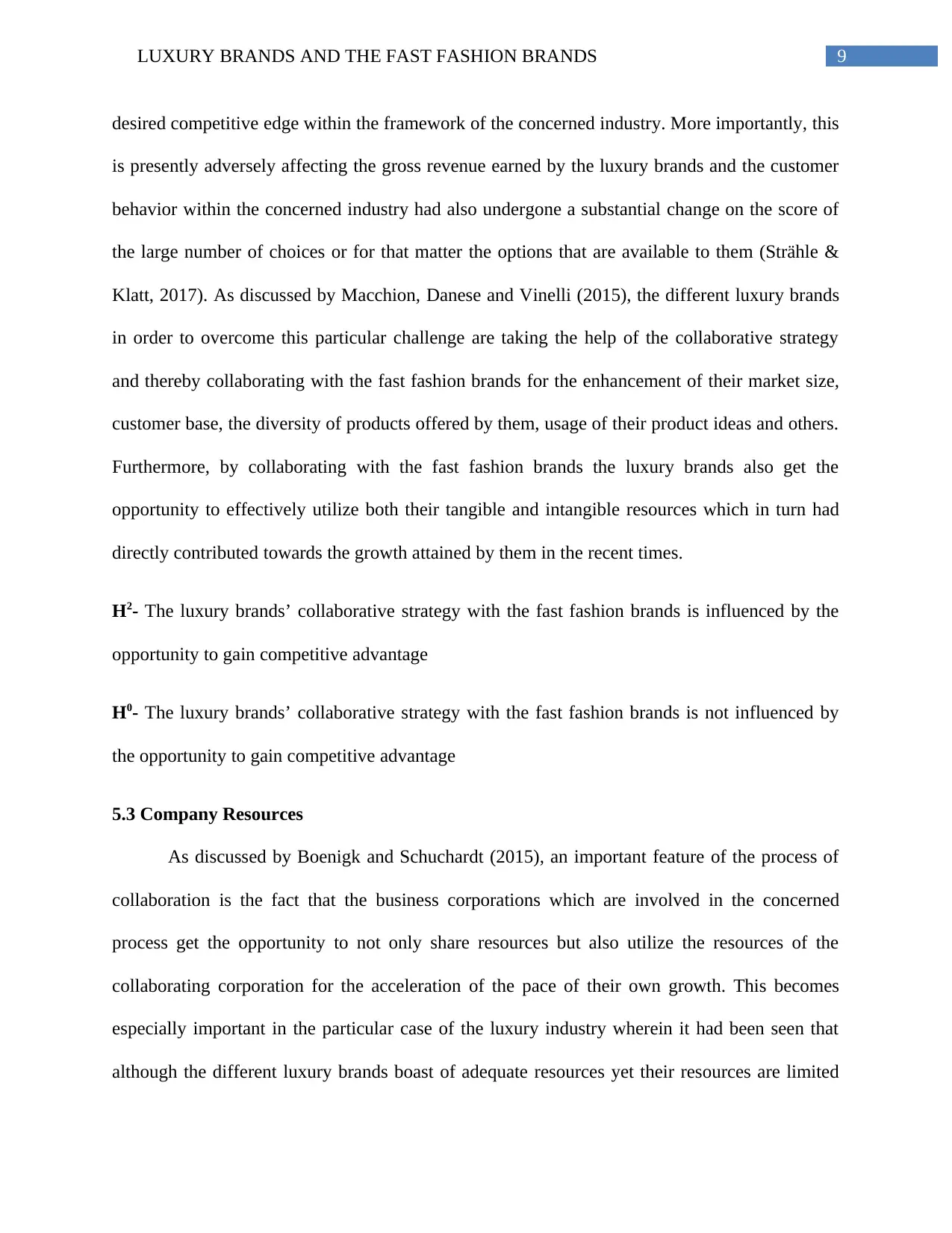
9LUXURY BRANDS AND THE FAST FASHION BRANDS
desired competitive edge within the framework of the concerned industry. More importantly, this
is presently adversely affecting the gross revenue earned by the luxury brands and the customer
behavior within the concerned industry had also undergone a substantial change on the score of
the large number of choices or for that matter the options that are available to them (Strähle &
Klatt, 2017). As discussed by Macchion, Danese and Vinelli (2015), the different luxury brands
in order to overcome this particular challenge are taking the help of the collaborative strategy
and thereby collaborating with the fast fashion brands for the enhancement of their market size,
customer base, the diversity of products offered by them, usage of their product ideas and others.
Furthermore, by collaborating with the fast fashion brands the luxury brands also get the
opportunity to effectively utilize both their tangible and intangible resources which in turn had
directly contributed towards the growth attained by them in the recent times.
H2- The luxury brands’ collaborative strategy with the fast fashion brands is influenced by the
opportunity to gain competitive advantage
H0- The luxury brands’ collaborative strategy with the fast fashion brands is not influenced by
the opportunity to gain competitive advantage
5.3 Company Resources
As discussed by Boenigk and Schuchardt (2015), an important feature of the process of
collaboration is the fact that the business corporations which are involved in the concerned
process get the opportunity to not only share resources but also utilize the resources of the
collaborating corporation for the acceleration of the pace of their own growth. This becomes
especially important in the particular case of the luxury industry wherein it had been seen that
although the different luxury brands boast of adequate resources yet their resources are limited
desired competitive edge within the framework of the concerned industry. More importantly, this
is presently adversely affecting the gross revenue earned by the luxury brands and the customer
behavior within the concerned industry had also undergone a substantial change on the score of
the large number of choices or for that matter the options that are available to them (Strähle &
Klatt, 2017). As discussed by Macchion, Danese and Vinelli (2015), the different luxury brands
in order to overcome this particular challenge are taking the help of the collaborative strategy
and thereby collaborating with the fast fashion brands for the enhancement of their market size,
customer base, the diversity of products offered by them, usage of their product ideas and others.
Furthermore, by collaborating with the fast fashion brands the luxury brands also get the
opportunity to effectively utilize both their tangible and intangible resources which in turn had
directly contributed towards the growth attained by them in the recent times.
H2- The luxury brands’ collaborative strategy with the fast fashion brands is influenced by the
opportunity to gain competitive advantage
H0- The luxury brands’ collaborative strategy with the fast fashion brands is not influenced by
the opportunity to gain competitive advantage
5.3 Company Resources
As discussed by Boenigk and Schuchardt (2015), an important feature of the process of
collaboration is the fact that the business corporations which are involved in the concerned
process get the opportunity to not only share resources but also utilize the resources of the
collaborating corporation for the acceleration of the pace of their own growth. This becomes
especially important in the particular case of the luxury industry wherein it had been seen that
although the different luxury brands boast of adequate resources yet their resources are limited
Paraphrase This Document
Need a fresh take? Get an instant paraphrase of this document with our AI Paraphraser
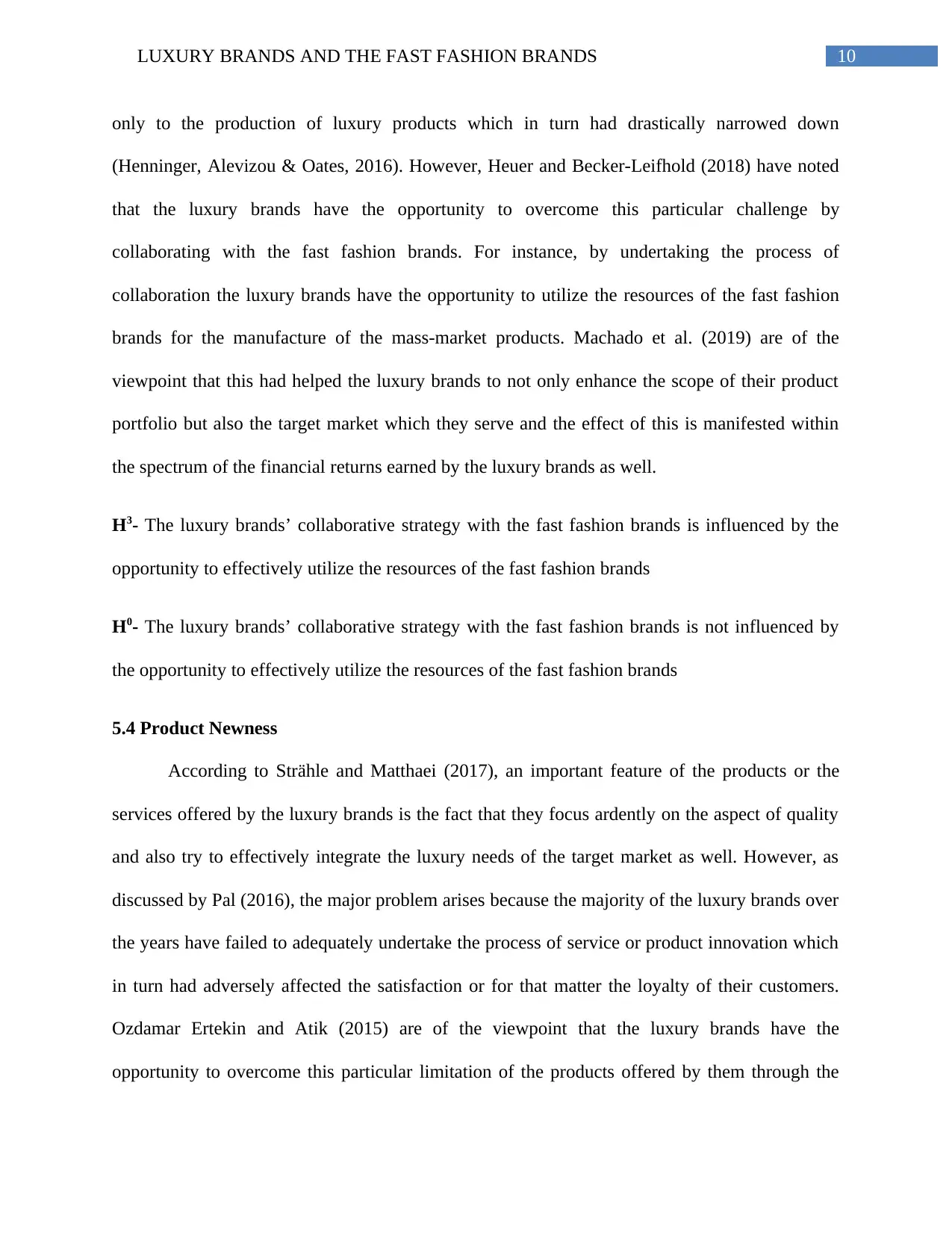
10LUXURY BRANDS AND THE FAST FASHION BRANDS
only to the production of luxury products which in turn had drastically narrowed down
(Henninger, Alevizou & Oates, 2016). However, Heuer and Becker-Leifhold (2018) have noted
that the luxury brands have the opportunity to overcome this particular challenge by
collaborating with the fast fashion brands. For instance, by undertaking the process of
collaboration the luxury brands have the opportunity to utilize the resources of the fast fashion
brands for the manufacture of the mass-market products. Machado et al. (2019) are of the
viewpoint that this had helped the luxury brands to not only enhance the scope of their product
portfolio but also the target market which they serve and the effect of this is manifested within
the spectrum of the financial returns earned by the luxury brands as well.
H3- The luxury brands’ collaborative strategy with the fast fashion brands is influenced by the
opportunity to effectively utilize the resources of the fast fashion brands
H0- The luxury brands’ collaborative strategy with the fast fashion brands is not influenced by
the opportunity to effectively utilize the resources of the fast fashion brands
5.4 Product Newness
According to Strähle and Matthaei (2017), an important feature of the products or the
services offered by the luxury brands is the fact that they focus ardently on the aspect of quality
and also try to effectively integrate the luxury needs of the target market as well. However, as
discussed by Pal (2016), the major problem arises because the majority of the luxury brands over
the years have failed to adequately undertake the process of service or product innovation which
in turn had adversely affected the satisfaction or for that matter the loyalty of their customers.
Ozdamar Ertekin and Atik (2015) are of the viewpoint that the luxury brands have the
opportunity to overcome this particular limitation of the products offered by them through the
only to the production of luxury products which in turn had drastically narrowed down
(Henninger, Alevizou & Oates, 2016). However, Heuer and Becker-Leifhold (2018) have noted
that the luxury brands have the opportunity to overcome this particular challenge by
collaborating with the fast fashion brands. For instance, by undertaking the process of
collaboration the luxury brands have the opportunity to utilize the resources of the fast fashion
brands for the manufacture of the mass-market products. Machado et al. (2019) are of the
viewpoint that this had helped the luxury brands to not only enhance the scope of their product
portfolio but also the target market which they serve and the effect of this is manifested within
the spectrum of the financial returns earned by the luxury brands as well.
H3- The luxury brands’ collaborative strategy with the fast fashion brands is influenced by the
opportunity to effectively utilize the resources of the fast fashion brands
H0- The luxury brands’ collaborative strategy with the fast fashion brands is not influenced by
the opportunity to effectively utilize the resources of the fast fashion brands
5.4 Product Newness
According to Strähle and Matthaei (2017), an important feature of the products or the
services offered by the luxury brands is the fact that they focus ardently on the aspect of quality
and also try to effectively integrate the luxury needs of the target market as well. However, as
discussed by Pal (2016), the major problem arises because the majority of the luxury brands over
the years have failed to adequately undertake the process of service or product innovation which
in turn had adversely affected the satisfaction or for that matter the loyalty of their customers.
Ozdamar Ertekin and Atik (2015) are of the viewpoint that the luxury brands have the
opportunity to overcome this particular limitation of the products offered by them through the
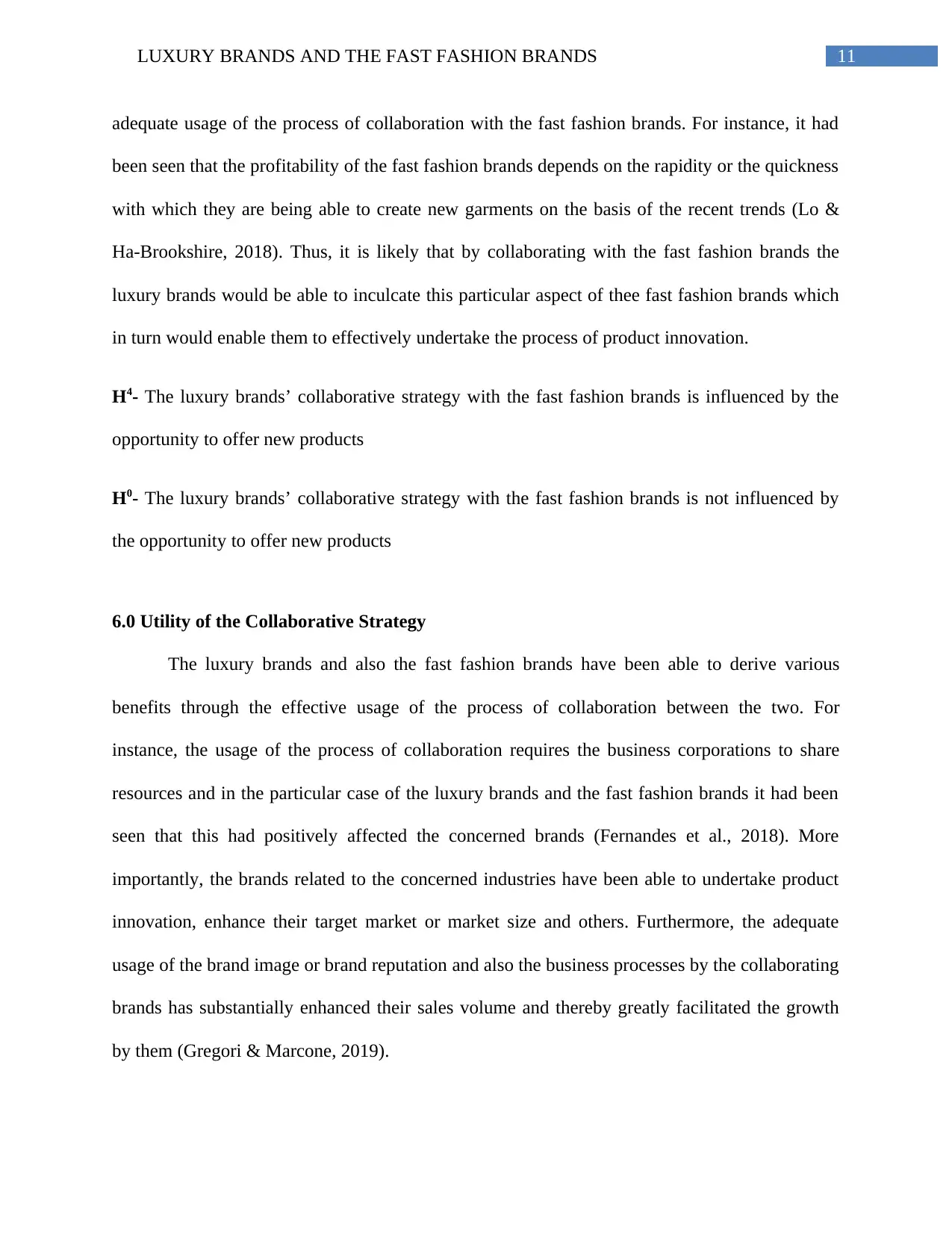
11LUXURY BRANDS AND THE FAST FASHION BRANDS
adequate usage of the process of collaboration with the fast fashion brands. For instance, it had
been seen that the profitability of the fast fashion brands depends on the rapidity or the quickness
with which they are being able to create new garments on the basis of the recent trends (Lo &
Ha-Brookshire, 2018). Thus, it is likely that by collaborating with the fast fashion brands the
luxury brands would be able to inculcate this particular aspect of thee fast fashion brands which
in turn would enable them to effectively undertake the process of product innovation.
H4- The luxury brands’ collaborative strategy with the fast fashion brands is influenced by the
opportunity to offer new products
H0- The luxury brands’ collaborative strategy with the fast fashion brands is not influenced by
the opportunity to offer new products
6.0 Utility of the Collaborative Strategy
The luxury brands and also the fast fashion brands have been able to derive various
benefits through the effective usage of the process of collaboration between the two. For
instance, the usage of the process of collaboration requires the business corporations to share
resources and in the particular case of the luxury brands and the fast fashion brands it had been
seen that this had positively affected the concerned brands (Fernandes et al., 2018). More
importantly, the brands related to the concerned industries have been able to undertake product
innovation, enhance their target market or market size and others. Furthermore, the adequate
usage of the brand image or brand reputation and also the business processes by the collaborating
brands has substantially enhanced their sales volume and thereby greatly facilitated the growth
by them (Gregori & Marcone, 2019).
adequate usage of the process of collaboration with the fast fashion brands. For instance, it had
been seen that the profitability of the fast fashion brands depends on the rapidity or the quickness
with which they are being able to create new garments on the basis of the recent trends (Lo &
Ha-Brookshire, 2018). Thus, it is likely that by collaborating with the fast fashion brands the
luxury brands would be able to inculcate this particular aspect of thee fast fashion brands which
in turn would enable them to effectively undertake the process of product innovation.
H4- The luxury brands’ collaborative strategy with the fast fashion brands is influenced by the
opportunity to offer new products
H0- The luxury brands’ collaborative strategy with the fast fashion brands is not influenced by
the opportunity to offer new products
6.0 Utility of the Collaborative Strategy
The luxury brands and also the fast fashion brands have been able to derive various
benefits through the effective usage of the process of collaboration between the two. For
instance, the usage of the process of collaboration requires the business corporations to share
resources and in the particular case of the luxury brands and the fast fashion brands it had been
seen that this had positively affected the concerned brands (Fernandes et al., 2018). More
importantly, the brands related to the concerned industries have been able to undertake product
innovation, enhance their target market or market size and others. Furthermore, the adequate
usage of the brand image or brand reputation and also the business processes by the collaborating
brands has substantially enhanced their sales volume and thereby greatly facilitated the growth
by them (Gregori & Marcone, 2019).
⊘ This is a preview!⊘
Do you want full access?
Subscribe today to unlock all pages.

Trusted by 1+ million students worldwide
1 out of 25
Related Documents
Your All-in-One AI-Powered Toolkit for Academic Success.
+13062052269
info@desklib.com
Available 24*7 on WhatsApp / Email
![[object Object]](/_next/static/media/star-bottom.7253800d.svg)
Unlock your academic potential
Copyright © 2020–2025 A2Z Services. All Rights Reserved. Developed and managed by ZUCOL.





